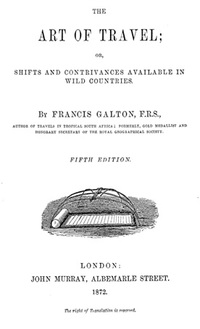Francis Galton`s book sendt British explorers out in the world. Originally published in 1855, this book was written after he returned from a historic journey into the African interior where he suffered much hardship and danger. After his return to England the famed explorer determined to teach travellers and soldiers the art of self-sufficiency in the field. His literary effort, The Art of Travel, became an instant classic and was used by several explorers who are famous today, including Sir Richard Francis Burton of Mecca fame.Galton was in contact with, and incorporated information from, many famous explorers, as for exampel Samuel Basker who discovered Lake Albert in 1864.
Sir Francis Galton (16 February 1822 – 17 January 1911) was an English Victorian polymath: anthropologist, eugenicist, tropical explorer, geographer, inventor, meteorologist, proto-geneticist, psychometrician, and statistician. He was knighted in 1909 (source: Wikipedia). Galton`s famous cousin, Charles Darwin, praised his book and considered it as valuable very for explorers: it will save lifes!
As Galton wrote in the introduction in the mentioned book: "The idea of the work occurred to me when exploring South-western Africa in 1850-51. I felt acutely at that time the impossibility of obtaining sufficient information on the subjects of which it treats ; for though the natives of that country taught me a great deal, it was obvious that their acquaintance with bush lore was exceedingly partial and limited. Then remembering how the traditional maxims and methods of travelling in each country differ from those of others, and how every traveller discovers some useful contrivances for himself, it appeared to me, that I should do welcome service to all who have to rough it,-whether explorers, emigrants, missionaries or soldiers, by collecting the scattered experiences of many such persons in various circumstances, collating them, examining into their principles, and deducing from them what might fairly be called an "Art of Travel." To this end, on my return home, I searched through a vast number of geographical works, I sought information from numerous travellers of distinction, and I made a point of re-testing, in every needful case, what I had read or learned by hearsay." Read the book electronically here.
You can also read the book electronically here.
The book is full of information about what the adventurers of the 19th century needed to know to explore unknown land. Read about what Victorian travellers thought about indigenous "savages", what kind of equipment they would take with them, how they would organise an expedition, how they prepared camp, what type of weapons they used, how they recorded their progress and location, and how they could make use of local materials. Readers will discover how to ride horses, handle elephants, and avoid cobras. Also included are sections on how to pull teeth, find water in a desert, and construct a sleeping bag out of fur. However The Art of Travel also includes detailed information not only on how to organize an African safari but how to discipline the irascible wives of the porters as well! Amply illustrated with dozens of nineteenth century drawings, this rediscovered classic remains fascinating reading for students of the horse or history.
In his early years Galton was an enthusiastic traveller, and made a notable solo trip through Eastern Europe to Constantinople, before going up to Cambridge. In 1845 and 1846 he went to Egypt and travelled down the Nile to Khartoum in the Sudan, and from there to Beirut, Damascus and down the Jordan.
In 1850 he joined the Royal Geographical Society, and over the next two years mounted a long and difficult expedition into then little-known South West Africa (now Namibia). He wrote a successful book on his experience, "Narrative of an Explorer in Tropical South Africa". He was awarded the Royal Geographical Society's gold medal in 1853 and the Silver Medal of the French Geographical Society for his pioneering cartographic survey of the region. This established his reputation as a geographer and explorer. He proceeded to write the mentioned best-selling The Art of Travel, which went through many editions and is still in print. Galton updated his book continuesly over 17 years.
Time has changed since the book was published, but the spirit in the book is still alive.
Stein Morten Lund, 13th February 2014












